New England's Chow Mein Sandwich Puts A Different Spin On Chinese Food
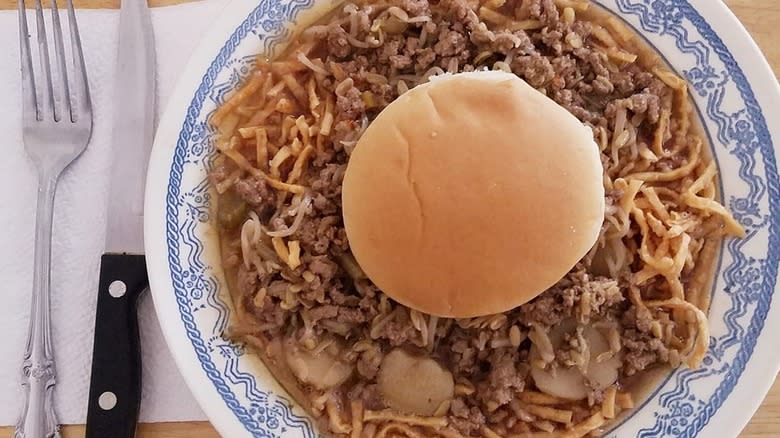
If there's one dish that truly represents cultural fusion, it's the chow mein sandwich. This Chinese-American meal, invented in Fall River, Massachusetts, takes chow mein, a traditional Chinese fried noodle dish, and sandwiches it in the middle of a hamburger bun.
19th-century Fall River created the perfect backdrop for this sandwich to blow up. The town was a mainstay of the textile industry in the 1800s and home to many factory workers from Europe and Canada. As more factories opened, Chinese restaurants were also cropping up, opened by immigrants who had previously arrived in New England. Chinese restaurant owners piled fried noodles, pork, vegetables, and gravy on a hamburger bun to make their food more familiar and appealing to European factory workers, thus combining a classic Chinese dish with the American sandwich concept.
Factory workers grew to love chow mein sandwiches because they were filling and inexpensive. At that time, it cost only five cents for a plate full of noodles spilling out of a bun; the sandwich often came with soda and French fries. Today, people still journey to Fall River to sample this marriage of cultures.
Read more: The Most Overrated Chain Restaurants In The US, According To The Mashed Staff
What's In A Chow Mein Sandwich?
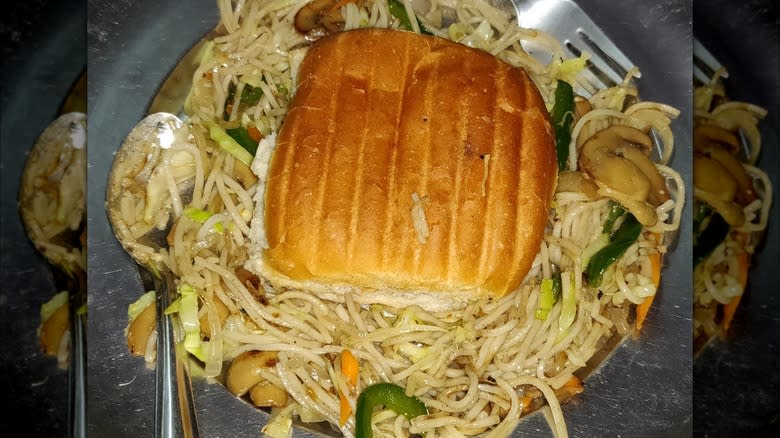
If you've eaten chow mein at a Chinese restaurant, you're likely familiar with the basic concept. This stir fried noodle dish is made with vegetables and meat and is a staple at Chinese spots in America. If you're traveling in New England and order a chow mein sandwich, you should expect to receive a heaping portion of it spilling out of a burger bun. The dish is probably 90% chow mein and 10% sandwich.
Chow mein is made from a sauce that features traditional Chinese flavors, like ginger, soy, garlic, and oyster sauce. This gravy also goes on top of the chow mein sandwich. However, the vegetables and meats can change depending on what is in stock or seasonally available. The noodles in this dish are made from eggs and get crispy as they cook in hot oil.
The sandwich portion of the chow mein sandwich describes the hamburger bun below and above the chow mein. Even though it's called a sandwich, you need a fork and knife to eat it because picking it up will result in a pile of fried noodles, veggies, meat, and sauce in your lap. According to some locals, the Fall River way to eat this meal is to douse it with vinegar.
How To Make A Chow Mein Sandwich
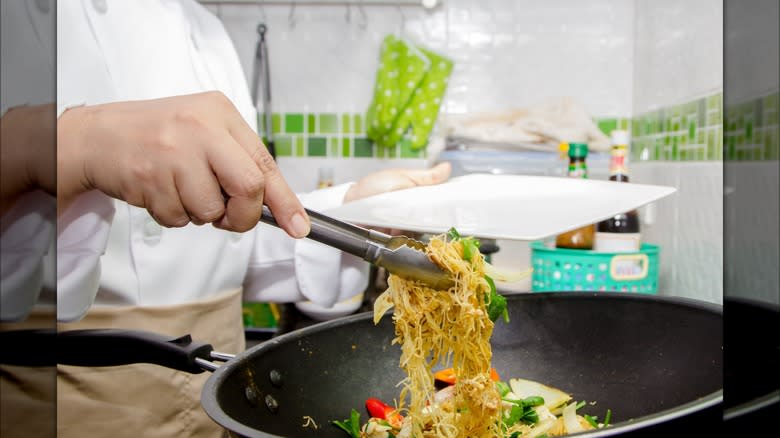
The chow mein sandwich has a rich, complex cultural history rooted in New England, but there's no need to travel to Massachusetts to try one. This dish is relatively simple to create from scratch in your kitchen. To start, you'll need a quick chow mein recipe for reference.
The first step is boiling the noodles. Once they're al dente, dry them off and drop them in hot oil to make them crispy. Next, sautee your meat and vegetables until they're cooked through. Use whatever vegetables you have on hand, or choose to highlight seasonal produce in your meal. Then, combine the vegetables and noodles in the pan. To complete the chow mein part of this dish, whip up the sauce, which typically includes ginger, soy sauce, garlic, and oyster sauce.
When you're ready to assemble your chow mein sandwich, put one half of the burger bun on the plate, spoon over the chow mein, and top it off with the sauce. Finish it by placing the remaining burger bun on top.
Variations Of The Chow Mein Sandwich
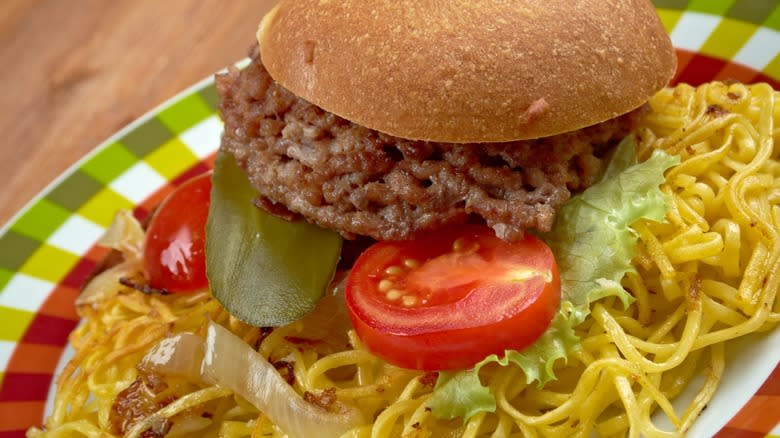
In Fall River, Massachusetts, one restaurant has served chow mein sandwiches for over 50 years. Mee Sum has an entire menu dedicated to this local favorite. What can you get on these loaded hybrid sandwiches? Pretty much whatever you want.
Because of the soupy, crunchy texture of chow mein, it's more of a stew with a side of bread than a sandwich. That being said, you can customize it in the same way you would a regular chow mein. Vegetarians can opt for versions that contain noodles and different combinations of vegetables. Meat eaters can choose from shrimp, chicken, beef, or pork.
People travel far and wide to try the chow mein sandwiches of legend at Mee Sum. Celebrity chef Emeril Lagasse is famously obsessed with them and even created a copycat recipe featuring vegetables and pork or beef. Other restaurants sell this dish, too. For instance, China Star, another Fall River restaurant, told Vice it sells 400 chow mein sandwiches weekly.
Fall River Residents Are Loyal To Local Chow Mein Noodles
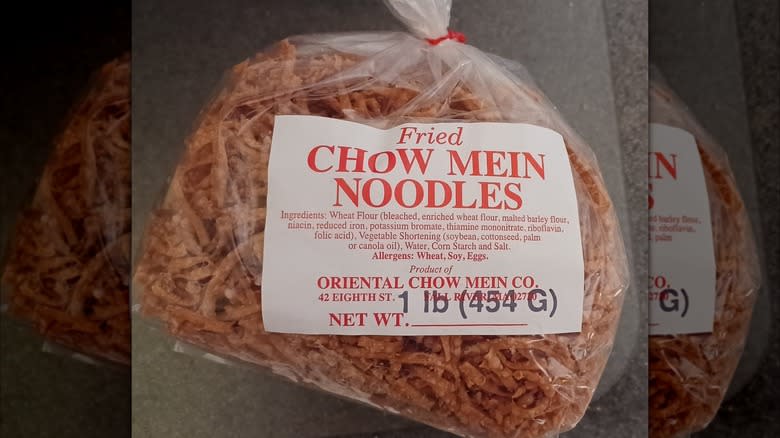
While you can make this dish at home, if you want to enjoy one at a restaurant, you'll be hard-pressed to track down a chow mein sandwich outside Fall River, Massachusetts. It's the true definition of a local delicacy right down to its roots in the 19th-century immigrant experience. Fall River residents are so serious about their chow mein sandwiches that they're even picky about the type of noodles that go into making it.
The go-to noodle for chow mein sandwiches is Hoo-Mee Noodles, a product by the Oriental Chow Mein Company, which is also located in Fall River. Frederick Wong, a Chinese immigrant, founded the Oriental Chow Mein Company in 1938. Hoo-Mee Fried Chow Mein Noodles are known for being skinny and supremely crispy; they're sold with a packet of gravy mix so customers can make their own chow mein or chow mein sandwich. After Wong's noodle factory burned down in 2009, customers begged for its return. Fortunately, the factory reopened in six months -- and still produces noodles today.
Read the original article on Mashed.

